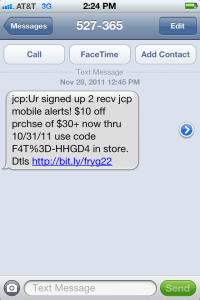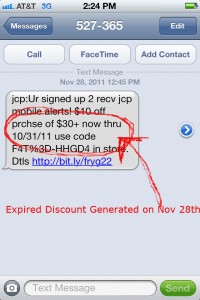New technology, like the quick response code, is fun for a lot of reasons.
It’s hip. It’s trendy. It creates buzz.
For the businesses who use it, the quick response code has that “We’re cool” factor.
It’s no secret in the marketing world that the quick response (QR) code is the latest trend to enter the digital scene. Quirky, sleek, and a little bit odd, the QR code stirs interest and leads customers to take action — a dream come true for any marketer.
A (Quick) History of the Quick Response Code
Quick response codes have been around since the 1990s, when Toyota used them as a way to keep track of plant inventory. These days, they can be seen on all sorts of advertising and marketing materials — from magazines to billboards to promotional material stuffed in your mailbox.
Put simply, a QR code provides a way to house a lot of digital data in a very small space that can be then be scanned or read by a “reader” (usually on a Smartphone) where the full view of that data (such as a website or a coupon) can be seen. QR codes, when used effectively, can save a company significant money while providing great value for the end user.
The Problem with the Quick Response Code
When used as a part of an overall strategic approach to marketing, the quick response code has a very nice role to play. However, like everything else in the digital space, the QR code has its drawbacks if not managed properly.
On Cyber Monday, I took my son shopping for some new holiday clothes at JC Penney. Penney’s has done a tremendous job of reinventing itself and also offering terrific bargains through in-store deals as well as printed coupons. Armed with the latest 15% off coupons, I marched up to the register with items in hand, only to discover the coupons I had were good only for items from the children’s department.
Not to worry. On the back of the coupon was a quick response code with the promise of “more savings sent right to your Smartphone!” After scanning the QR code, I was asked to input the usual information required these days: name, email, mobile phone number. Here is a photo of the text I was sent upon submitting my information:
Make Sure Your Quick Response Code Is Up to Date
I have to admit, I liked the instant gratification of getting this $10 savings sent right to my phone. I was all ready to hand it over to the clerk so he could enter the discount code into his computer when I noticed a BIG problem.
I was shopping on November 28th. The QR code that I had scanned had appeared on a mailing delivered to me only a week earlier, yet the quick response code that mailing featured took me to a coupon that expired on October 31, 2011.
In my opinion, this is not a little “Oops.” This is a HUGE faux pas on JC Penney’s part. Not only did it slow down my purchasing experience, but it embarrassed me in front of the clerk and my son. It also made me wonder who exactly is in charge of JC Penney’s national marketing department.
I understand things can slip through the cracks here and there, especially in this age of technological overwhelm. But I have very little tolerance for a company as big as JC Penney who can afford to hire the best of the best when it comes to digital talent.
If you are going to use a quick response code on your direct mail campaign (or any campaign for that matter), doesn’t it make sense to check the code to ensure the information on the other end is up to date? If you don’t, you risk losing credibility with your customer, as well as having blog posts written about your ineptitude. From now on, I am more likely to mistrust the QR codes JC Penney includes on its direct mail. No company wants to breed mistrust in its customers.
Using new technology is a great way for businesses to make a splash in their markets. More and more people are responding to QR codes. Just make sure if you use a quick response code, you are sending your target market to relevant and timely information.
If my experience with an expired QR code compels you to spread the word, please share this post with your circles. Also, what experiences have you had with a quick response code, either as a marketer or a consumer?


